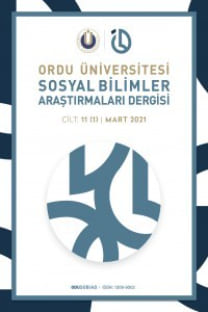Giresun'da Doğal Olarak Yetişen Yenilebilir Mantarların Gastronomik Değeri
Mantarların Türk ve Dünya mutfaklarında kullanımı hızla artmakta, özellikle son yıllarda yabani mantar toplayıcılığı ve tüketiminde önemli artışlar yaşanmaktadır. Çalışma ile Giresun mutfağında yenilebilir yabani mantarların hangi türlerinin tüketildiği ve mantar yemeklerinin araştırılması amaçlanmıştır. Çalışmada nitel araştırma yöntemi tercih edilmiştir. Çalışmada öncelikle saha incelemesi yapılmıştır. Araştırmanın evrenini Giresun il sınırları içerisinde yaşayan yenilebilir yabani mantarları bilen ve bu mantarları mutfaklarında kullanan, konu hakkında bilgi ve deneyimi olan kişiler oluşturmaktadır. Çalışmada kartopu örnekleme yöntemi kullanılmıştır. Giresun Bulancak, Merkez, Keşap, Eynesil, Dereli, Yağlıdere, Şebinkarahisar ve Alucra ilçelerinde 23 kişi ile görüşülmüş veri toplanmıştır. Araştırma sonucuna göre Giresun ilinin kadimden gelen yenilebilir mantar çeşitliğine ve yemek kültürüne sahip olduğu, ilde 18 aileye mensup 45 mantar türünün tüketildiği, mantarlardan köfte, kavurma, kızartma, közleme, diple, pilavdan oluşan çok çeşitli yemeklerinin yapıldığı tespit edilmiştir.
Gastronomic Value of Naturally Grown Edible Mushrooms in Giresun
The use of mushrooms in Turkish and World cuisines is increasing rapidly, especially in recent years, there has been a significant increase in wild mushroom picking and consumption. The aim of this study is to investigate which types of edible wild mushrooms are consumed and mushroom dishes in Giresun cuisine. Qualitative research method was preferred in the study. In the research, a field study was carried out. The population of the research consists of people who know the edible wild mushrooms living within the borders of Giresun province and use these mushrooms in their kitchens and have knowledge and experience on the subject. Snowball sampling method was used in the study. Semi-structured interviews were conducted with 23 people in Giresun Bulancak, Merkez, Keşap, Eynesil, Dereli, Yaglidere, Şebinkarahisar and Alucra districts. According to the results of the research, it has been determined that Giresun province has an ancient variety of edible mushrooms and food culture, 45 mushroom species belonging to 18 families are consumed in the province and a wide variety of dishes consisting of meatballs, roasting, frying, roasting, dip and rice are made from mushrooms
___
- Akman, M., & Baysal, A. (1984). Ege Bölgesinde Besin Olarak Kullanılan Mantar Türleri ve Tüketim Sıklığı Üzerinde Bir Araştırma. Beslenme ve Diyet Dergisi, 13, 107-112.
- Altunışık, R., Coskun, R., Bayraktaroğlu, S., & Yıldırım, E. (2012). Sosyal bilimlerde araştırma yöntemleri SPSS uygulamalı. Sakarya: Sakarya Kitabevi.
- Anonim1. (2022, Mayıs 02). Pleurotus pulmonarius. https://www.inaturalist.org/guide_taxa/498929.
- Anonim2. (2022, Mayıs 2022). Pleurotus Eryngii. https://mantarliyasam.com/pleurotus-eryngii/.
- Anonim3. (2022, 05 2022). Kıvırcık Mantar. https://www.naturephoto-cz.com/kivircik-mantari- picture_tr-15202.html.
- Anomim4. (2022, Mayıs 02). Lactarius Chrysorrheus. https://commons.wikimedia.org/wiki/File:Lactarius_ chrysorrheus_3316224. jpg.
- Anonim5. (2022, Mayıs 02). Lactarius Uvidus. https://alchetron.com/Lactarius-uvidus.
- Anonim6. (2022, Mayıs 02). Lactarius Lacunarum. https://www.pharmanatur.com/Mycologie/Lactarius%20 lacunarum.htm.
- Bakratsas, G., Polydera, A., Katapodis, P., & Stamatis, H. (2021). Recent trends in submerged cultivation of mushrooms and their application as a source of nutraceuticals and food additives. Future Foods, 4(September), 100086. https://doi.org/10.1016/j.fufo.2021.100086
- Barutçiyan, J. (2012). Türkiye’nin Mantarları -1. İstanbul: Oğlak Yayınları.
- Biernacki, P., & Waldorf, D. (1981). Snowball sampling: Problems and techniques of chain referral sampling. Sociological Methods & Research, 10(2), 141-163.
- Birer, S. (1985). Yemeklik mantarın beslenmemizdeki yeri ve değerlendirilmesi. Beslenme ve Diyet Dergisi, 14, 139-152.
- Boa, E. (2008). Wild Edible Fungi a global overview of their use and importance to people. In Biology. Food and Agriculture Organization of the United Nations. www.fao.org/3/a-y5489e.pdf
- Büyüköztürk, Ş., Kılıç Çakmak, E., Akgün, Ö. E., Karadeniz, Ş., & Demirel, F. (2018). Eğitimde bilimsel araştırma yöntemleri. Ankara: Pegem Akademi.
- Conte, A. del, & Læssøe, T. (2008). The edible mushroom book. A guide to foraging and cooking. London: DK Publishing.
- Erdem, Y. (2016). Mantar Avcısının El Kitabı. İstanbul: Ntv Yayınları. Eren, R., Süren, T., & Kızılelli, M. (2017). Gastronomik Açıdan Türkiye’de Yenilebilir Mantarlar. Turizm Akademik Dergisi, 4(2017), 77–89.
- Guba, E. G., & Lincoln, Y. S. (1982). Epistemological and methodological bases of naturalistic inquiry. Ectj, 30(4), 233-252.
- Kamil, M. (2015). Aşçıların Sığınağı. İstanbul: T.C. Yazma Eserler Kurumu Başkanlığı.
- Kibar, B. (2015). Iğdır İli Mantar Tüketim Alışkanlıklarının Belirlenmesi Determination of Mushroom Consumption Habits in Igdir Province. Iğdır Üniversitesi Fen Bilimleri Enstitüsü Dergisi, 5(4), 9–16.
- Kurt, R., & Karayilmazlar, S. (2019). Mushroom production and projection in Turkey using ARIMA (Box-Jenkins). Turkish Journal of Forestry Research, 6(1), 72–76. DOI: https://doi.org/10.17568/ogmoad.461534
- Mackley, L. (2004). Mushroom. Bath: Parragon Publishing.
- Marrone, T. & Parker, D. (2019). Mushroom of the Northwest. Cambridge: Adventure Publications.
- Millman, L. (2017). Fungipedia. Princeton: Princeton University Press.
- Nicholas, L. G., & Ogame, K. (2006). Psilocybin mushroom handbook: easy indoor & outdoor cultivation. Oakland: Quick American Publishing.
- Sesli, E., Asan, A. & Selçuk, F. (2020). Türkiye Mantarlar Listesi. İstanbul: Ali Nihat Gökyiğit Vakfı.
- Stemler, S. (2001). An overview of content analysis. Practical Assessment. Practical Assessment Research & Evaluation, 17(7), 1-17.
- Şimşek, A. & Önek, Ü. M. (2021). Yenilebilir Mantar Tüketimi ve Yemekleri Üzerine Bir İnceleme: Kastamonu Örneği. OCAK: Türk Mutfak Kültürü Araştırmaları Dergisi, 1(1), 21-30.
- Wu, H. L., & Volker, D. L. (2009). The use of theory in qualitative approaches to research: application in end of life studies. Journal of advanced nursing, 65(12), 2719-2732.
- Yayla, Ö. & Günay Aktaş, S. (2021). Mise en place for gastronomy geography through food: Flavor regions in Turkey. International Journal of Gastronomy and Food Science, 26(June), 100384.
- ISSN: 1309-9302
- Yayın Aralığı: Yılda 3 Sayı
- Başlangıç: 2010
- Yayıncı: -
Sayıdaki Diğer Makaleler
Yabancı Para Pozisyonunun Firma Kârlılığına Etkisi: Borsa İstanbul Örneği
Miray BEŞBUDAK, Neslihan ÖZMELEK TAŞ, Azra K. NAZLI
Sovyet Sonrası Alanda Tarihyazımının Sınırları: Kazakistan, Özbekistan ve Tacikistan
Pandemi Sürecinde Kadın Girişimcilerin İş ve Aile Yaşamları
Güler ZEYTÜNÜ, Çağdaş Ümit YAZGAN
John Locke’un Kişisel Özdeşlik Teorisindeki Problemler
Giresun'da Doğal Olarak Yetişen Yenilebilir Mantarların Gastronomik Değeri
